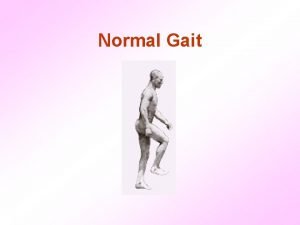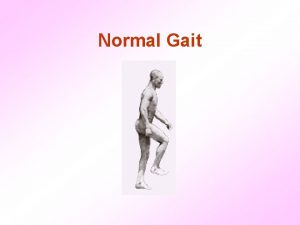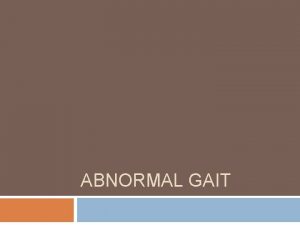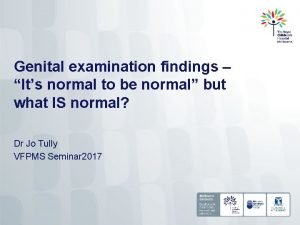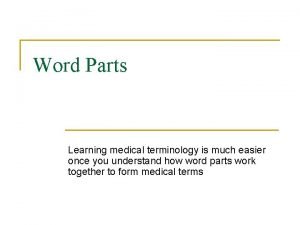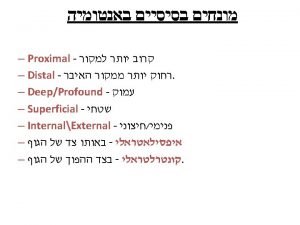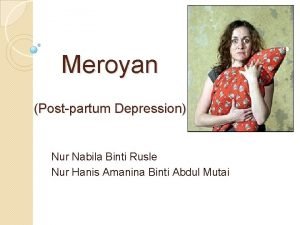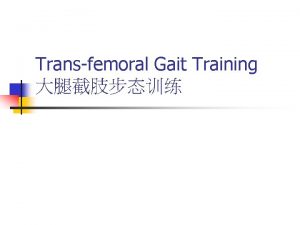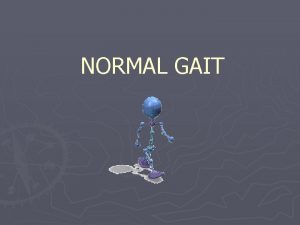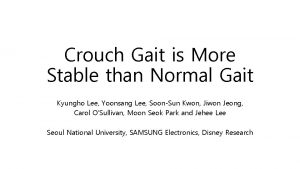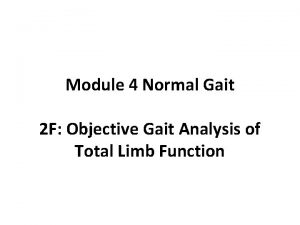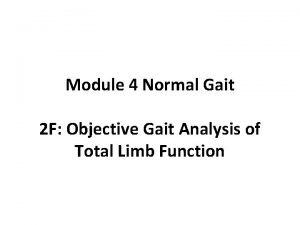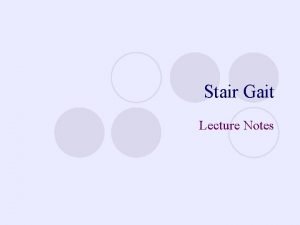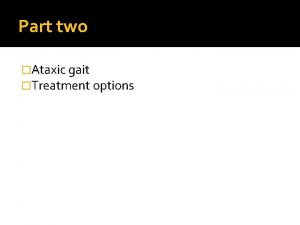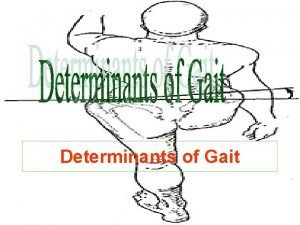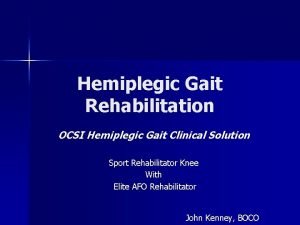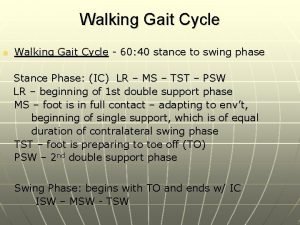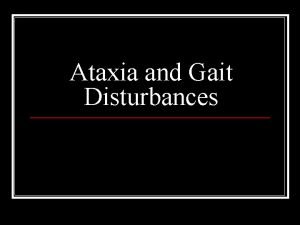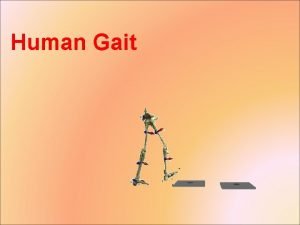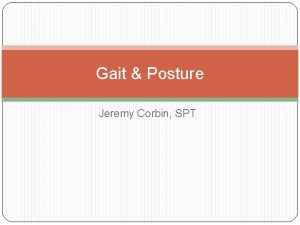Normal Gait Gait is the medical term to






















- Slides: 22

Normal Gait

• Gait is the medical term to describe human locomotion, or the way, the manor and the style that we walk. Interestingly, every individual has a unique gait pattern.

Definition: • Physiological Definition: • It is a mechanism which depends upon closely integrated action musculoskeletal, peripheral and central nervous system, visual, vestibular, auditory and sensory-motor systems. • The degree of integration determines the different gait patterns. Any defect of any part of them or all of them will lead to pathological gait. • Mechanical definition; • It is a form of bipedal locomotion as there is an alternating action between lower extremities. • Gait is the result of a series of rhythmic alternating movement of arms, legs, and trunk which create forward movement of the body.

Prerequisites of gait There are (4) major criteria essential to walking. Equilibrium: The ability to assume an upright posture and maintain balance. Locomotion: The ability to initiate and maintain rhythmic stepping, which requires: Musculoskeletal Integrity: Ø Adequate R. O. M. Ø Muscle strength. Ø Appropriate bone structure and joint. Neurological Control: • • C. N. S. maturation and adequate motor control to receive and send messages telling the body how and when to move. Intact visual, vestibular, auditory and sensory-motor input.

Forces for gait: Muscular force. Gravitational force. Forces of momentum. Floor reaction force. • The normal walking has five major attributes: • • • Stability in stance. Sufficient foot clearance in swing. Appropriate preposition of the foot for contact. Adequate step length. Energy conservation

Gait cycle (Stride cycle) • The gait cycle (Stride cycle) • This cycle describes the motions from initial placement of the supporting heel on the ground to when the same heel contacts the ground for a second time.

Phases of Gait cycle (Stride Cycle) Stance Phase Weight acceptance I. C. L. R. Swing Phase Single Limb Support M. St. T. St. Limb advancement P. Sw. I. Sw. M. Sw. T. Sw.

Each gait cycle can be described in the phasic terms. • Stance Phase: It begins the instant the heel contacts the ground (heel strike) and ends when only the toe of the same extremity is on the ground (toe-off). The foot is in contact with the supporting surface at all times. The stance phase makes up 60% of the gait cycle.

2) Loading Response • The loading response phase occupies about 10 percent of the gait cycle and constitutes the period of initial double-limb support. • During loading response, the foot comes in full contact with the floor, and body weight is fully transferred onto the stance limb. • The initial double-support stance period occasionally is referred to as initial stance. • The term foot flat (FF) is the point in time when the foot becomes plantar grade.

• The double stance period beginning • Body weight is transferred onto the red leg. • It is important for shock absorption, weight-bearing, and forward progression. • The blue leg is in the pre-swing phase

3) Mid-stance • Mid-stance represents the first half of single support. • which occurs from the 10 - to 30 -percent periods of the gait cycle. • It begins when the contra-lateral foot leaves the ground and continues as the body weight travels along the length of the foot until it is aligned over the forefoot.

• single limb support interval. • Begins with the lifting of the blue foot and continues until body weight is aligned over the red (supporting) foot. • The red leg advances over the red foot The blue leg is in its mid-swing phase.

4)Terminal Stance • Terminal stance constitutes the second half of single-limb support. • It begins with heel rise and ends when the contra-lateral foot contacts the ground. Terminal stance occurs from the 30 - to 50 - percent periods of the gait cycle. During this phase, body weight moves ahead of the forefoot. • The term heel off (HO) is a descriptor useful in observational analysis and is the point during the stance phase when the heel leaves the ground. • Begins when the red heel rises and continues until the heel of the blue foot hits the ground. • Body weight progresses beyond the red foot

• Begins when the red heel rises and continues until the heel of the blue foot hits the ground. • Body weight progresses beyond the red foot

Stance Phase Characteristics • During a single stride, there are 2 periods of double limb support (both feet on ground): – Loading response (right) & Toe Off (left) – Loading response (left) & Toe Off (right)

Gait Progression

2) Swing Phase: • It is defined as the interval in which the foot is not in contact with the ground denotes the time when the foot is in the air, constituting the remaining 40% of the gait cycle. • The swing phase could be defined as the phase when all portions of the foot are in forward motion.

Swing is divided into two phases: § § • The swing period primarily is divided into three phases: Acceleration (Acc) (initial swing) - begins once the toe leaves the ground and continues until mid-swing or the point at which the swinging limb is directly under the body. Mid-swing (MSW) - occurs when the extremity passes directly beneath the body. Deceleration (Dec) (terminal swing) - occurs after mid-swing when the tibia passes beyond the perpendicular and the knee is extending in preparation for heel strike. Pre-swing, however, prepares the limb for swing advancement and in that sense could be considered a component of swing phase.

Pre-swing • • • • Pre-swing is the terminal double-limb support period and occupies the last 12 percent of stance phase, (from 50 percent to 62 percent. ) It begins when the contra-lateral foot contacts the ground and ends with ipsilateral toe off. During this period, the stance limb is unloaded and body weight is transferred onto the contra-lateral limb. The termination of stance and the onset of swing is defined as the point where all portions of the foot have achieved motion relative to the floor.

b) Initial Swing • The initial one-third of the swing period, from the 62 - to 72 -percent periods of the gait cycle (10%), is spent in initial swing. • It begins when the foot leaves the ground and continues until maximum knee flexion occurs, • when the swinging extremity is directly under the body and directly opposite the stance limb.

c) Mid-swing occurs in the second third of the swing period, from the 75 to 85 -percent periods of the gait cycle. (10%) Critical events include continued limb advancement and foot clearance. This phase begins following maximum knee flexion and ends when the tibia is in a vertical position.

d) Terminal Swing • In the final phase of terminal swing from the 85 - to 100 percent periods of the gait cycle(15%), • The tibia passes beyond perpendicular, and the knee fully extends in preparation for heel contact.
 Normal gait medical term
Normal gait medical term Prerequisites of gait
Prerequisites of gait Medical terminology body positions
Medical terminology body positions Gait of sensory ataxia
Gait of sensory ataxia Hymen
Hymen Short, medium and long term planning in education
Short, medium and long term planning in education Term-to-term rule
Term-to-term rule Long term memory vs short term memory
Long term memory vs short term memory Fraction sequence
Fraction sequence Short term human resource planning
Short term human resource planning Position to term rule worksheet
Position to term rule worksheet Difference between long term and short term liabilities
Difference between long term and short term liabilities Accounting for serial bonds
Accounting for serial bonds Minterm maxterm
Minterm maxterm Rules in finding the nth term
Rules in finding the nth term Term to term rule
Term to term rule Short term goals examples
Short term goals examples Short term and long term cash forecasting
Short term and long term cash forecasting -in suffix medical term
-in suffix medical term Medical terminology notes
Medical terminology notes Urethratresia definition
Urethratresia definition Arthroclasia adalah
Arthroclasia adalah Meroyan in medical term
Meroyan in medical term
